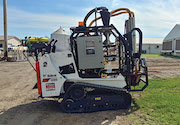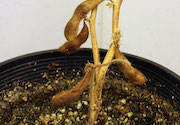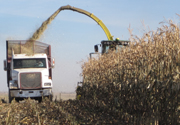| |
| |
 |
 |
| |
 |
|
October 31, 2019 |
|
| |
Doug Cattani, a crop researcher at the University of Manitoba focusing on intermediate wheatgrass, was recently named a recipient of a Manitoba Excellence in Sustainability Award.
» Read more...
Introducing fungi to wheat boosted the uptake of key nutrients and could lead to new, climate smart varieties of crops, according to a new study out of the University of Leeds.
» Read more...
Sawyer Farms in Acme, Alta. grows 4,200-acres of canola, wheat and malt barley and is one of the two farms profiled in an agriculture documentary series that hopes to demystify food production in Canada.
» Read more...
|
| |
|
| |

Get serious Flea Beetle and cutworm protection. Get maximum early season insect protection.
When you've planted Lumiderm™ treated canola seed, your crop will gain an advantage over both cutworms and Flea Beetles. This enhanced protection is critical during the first few weeks of seedling growth, which will allow your canola crop to thrive. Not only does Lumiderm provide enhanced protection on both cutworms and Flea Beetles, it also has led to substantial increases in plant vigour and biomass.
Here’s what you need to know:
- Enhanced crucifer and striped Flea Beetle protection
- Excellent control of early season cutworms
- Excellent early season seedling stand establishment, vigour and biomass
- Up to 35 days of protection through the critical stages of seedling growth
- Novel class of chemistry (Group 28) for resistance management
- Lumiderm resulted in a positive yield advantage 78% of the time across western Canada1 with 35% less Flea Beetle damage2 (1.4 bu/ac average yield3 increase)
Ask your local seed supplier about Lumiderm and learn more at
lumiderm.corteva.ca.
1 Results from large scale grower managed field trials across Western Canada in 2015.
2 Source: 192 DuPont Research & Development (replicated) trials and Grower Demo strip trials (2010-2015).
3 Source: Canola yield averaged across 137 Grower Demo Strips, Western Canada (2013-2015).
®, ™ Trademarks of Dow AgroSciences, DuPont or Pioneer and affiliated companies or their respective owners. ©2019 CORTEVA.

|
| |
|
| |
 Can removing humans from the equation improve the accuracy of soil sampling? A company in West Lafayette, Ind. is building robotic soil sampling machines on top of a Bobcat skid steer platform that autonomously works a field, pulling soil samples, and bagging them. But how did it stack up in capacity and accuracy when compared to a human sampler?
» Learn more
Can removing humans from the equation improve the accuracy of soil sampling? A company in West Lafayette, Ind. is building robotic soil sampling machines on top of a Bobcat skid steer platform that autonomously works a field, pulling soil samples, and bagging them. But how did it stack up in capacity and accuracy when compared to a human sampler?
» Learn more |
| |
 Stubble loss – where the lowest pods on soybean plants remain attached to the stubble after harvest – can be a costly and frustrating yield loss problem. And it’s a problem that is a particular concern with the soybean varieties grown on the Prairies. Low pod height causes one of the main header losses, so a Manitoba research project is determining whether plant growth regulators might offer an effective way to increase pod height.
» Learn more
Stubble loss – where the lowest pods on soybean plants remain attached to the stubble after harvest – can be a costly and frustrating yield loss problem. And it’s a problem that is a particular concern with the soybean varieties grown on the Prairies. Low pod height causes one of the main header losses, so a Manitoba research project is determining whether plant growth regulators might offer an effective way to increase pod height.
» Learn more |
| |
|
| |

Pioneer ® brand offers more silage corn products than any other corn company in Western Canada, from the earliest maturing silage corn hybrids, to full-season hybrids. Within the Pioneer ® brand corn product range, get root worm and corn borer protection with our new Optimum ® AcreMax ® Xtreme technology. All Pioneer ® brand corn hybrids are bred in the West at our Corteva Agriscience™ research stations and are tested to ensure consistent performance in each maturity zone. Together, Pioneer ® brand corn products offer you exceptional nutritional quality with high starch content and leading tonnage yields for your livestock.
To learn more contact your Pioneer sales representative or visit
pioneer.com
|
| |
|
| |
 Corn silage has great potential in Western Canada. But like any crop, producers must be aware of the challenges associated with growing, and plan carefully for next year’s season. Western Canadian corn producers don’t get the luxury of time that others have, so making the most of the time you have is critical, from planting to harvesting. “Corn hybrids respond very different by geography. Be sure that you’re growing a product that you know will perform and finish well in your area.”
» Read more here on choosing your 2020 corn hybrids
Corn silage has great potential in Western Canada. But like any crop, producers must be aware of the challenges associated with growing, and plan carefully for next year’s season. Western Canadian corn producers don’t get the luxury of time that others have, so making the most of the time you have is critical, from planting to harvesting. “Corn hybrids respond very different by geography. Be sure that you’re growing a product that you know will perform and finish well in your area.”
» Read more here on choosing your 2020 corn hybrids |
| |
|
| |
|
|
| |
| |








